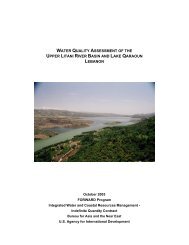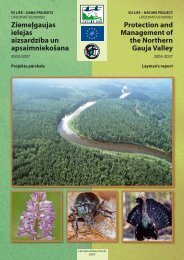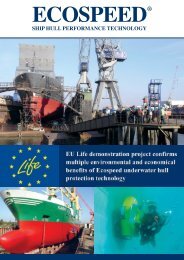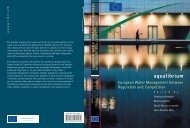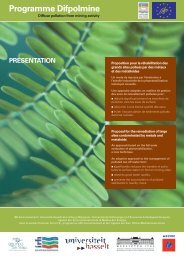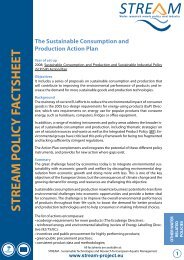Development and Validation of an Automated ... - wise-rtd.info
Development and Validation of an Automated ... - wise-rtd.info
Development and Validation of an Automated ... - wise-rtd.info
You also want an ePaper? Increase the reach of your titles
YUMPU automatically turns print PDFs into web optimized ePapers that Google loves.
Laym<strong>an</strong> Report . Realization<br />
5<br />
2 Realization<br />
2.1 Immunoassays<br />
Immunoassays are chemical tests used to detect or qu<strong>an</strong>tify a specific subst<strong>an</strong>ce,<br />
the <strong>an</strong>alyte, in a blood or body fluid sample, using <strong>an</strong> immunological reaction.<br />
Immunoassays are highly sensitive <strong><strong>an</strong>d</strong> specific. Their high specificity results from<br />
the use <strong>of</strong> <strong>an</strong>tibodies <strong><strong>an</strong>d</strong> purified <strong>an</strong>tigens as reagents. An <strong>an</strong>tibody is a protein<br />
(immunoglobulin) produced by B-lymphocytes (immune cells) in response to<br />
stimulation by <strong>an</strong> <strong>an</strong>tigen. Immunoassays measure the formation <strong>of</strong> <strong>an</strong>tibody-<strong>an</strong>tigen<br />
complexes <strong><strong>an</strong>d</strong> detect them via <strong>an</strong> indicator reaction.<br />
The purpose <strong>of</strong> <strong>an</strong> immunoassay is to measure <strong>an</strong> <strong>an</strong>alyte. Common uses include<br />
measurement <strong>of</strong> drugs, hormones, specific proteins, tumor markers, <strong><strong>an</strong>d</strong> markers <strong>of</strong><br />
cardiac injury. Radioimmunoassay (RIA) is a method employing radioactive<br />
isotopes to label either the <strong>an</strong>tigen or <strong>an</strong>tibody. The major adv<strong>an</strong>tages <strong>of</strong> RIA,<br />
compared with other immunoassays, are higher sensitivity, easy signal detection,<br />
<strong><strong>an</strong>d</strong> well-established, rapid assays. The major disadv<strong>an</strong>tages are the health <strong><strong>an</strong>d</strong><br />
safety risks posed by the use <strong>of</strong> radiation <strong><strong>an</strong>d</strong> the time <strong><strong>an</strong>d</strong> expense associated with<br />
maintaining a licensed radiation safety <strong><strong>an</strong>d</strong> disposal program.<br />
Enzyme immunoassay (EIA) as developed as <strong>an</strong> alternative to radioimmunoassay<br />
(RIA). These methods use <strong>an</strong> enzyme to label either the <strong>an</strong>tibody or <strong>an</strong>tigen. The<br />
sensitivity <strong>of</strong> EIA approaches that for RIA, without the d<strong>an</strong>ger posed by radioactive<br />
isotopes. One <strong>of</strong> the most widely used EIA methods is the enzyme-linked<br />
immunosorbent assay (ELISA).<br />
For a long time immunoassays belong to the routine methods in biochemistry <strong><strong>an</strong>d</strong><br />
medical diagnosis. However in the last 10-15 years their import<strong>an</strong>ce in different areas<br />
like the environmental <strong>an</strong>alysis <strong><strong>an</strong>d</strong> food inspection increased intensely. They are<br />
used for the determination <strong>of</strong> environmental contaminates (aromatic hydrocarbons,<br />
pesticides or explosives in soil or water), food additive <strong><strong>an</strong>d</strong> pharmaceuticals.<br />
For the determination <strong>of</strong> subst<strong>an</strong>ces with small sizes <strong>of</strong> molecules, immunoassays<br />
compete with chromatographic methods that are mainly applied today.<br />
Immunoassays have several adv<strong>an</strong>tages compared to other <strong>an</strong>alytical methods: they<br />
are fast <strong><strong>an</strong>d</strong> inexpensive <strong><strong>an</strong>d</strong> the <strong>an</strong>alysis does not require long-winded cle<strong>an</strong>-up<br />
quo data GmbH 10.11.2005




